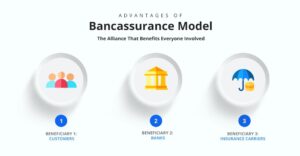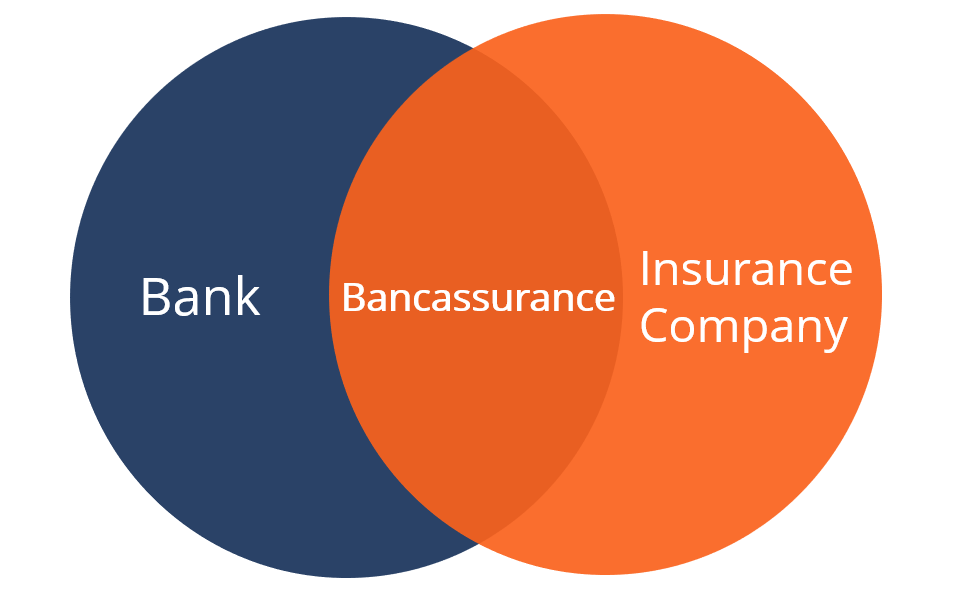Bancassurance is the selling of insurance products via banks. Banks sell various types of bancassurance products and earn revenues. The concept of bancassurance originated in France, and later in 2000, it was introduced in India. Earlier, insurance products sale was through agents, which was the main source of revenue for the insurance retail segment. Then, Insurance Regulatory and Development Authority (IRDA) initiated the registration of insurance companies in India. Further, the government of India specified ‘Insurance‘ as a business which banks could undertake under section 6(1) of the Banking Regulation Act of 1949. However, any bank intending to take up such business requires prior approval from the Reserve Bank of India (RBI).
All scheduled commercial banks can undertake insurance business as agents on a fee basis without risk participation. If a bank wishes to enter into a joint venture with an insurance company with risk participation, it must adhere to different rules. With privatization, private players in the insurance business increased, and the competition intensified. Since 2000, the Indian insurance sector is progressing.
In India, two separate bodies regulate the insurance and banking segment- IRDA and RBI, respectively. Therefore, bancassurance comes under the purview of both the regulatory bodies RBI and IRDA.

Types of Bancassurance Models in India
In India, companies generally follow Corporate Agency Regulations. According to the rules and regulations, banks become corporate agents for one life insurance company and one non-life insurance company against a commission. They cannot participate in any other payout other than commission. They also need to follow a code of conduct towards the customer and the insurance company.
Moreover, in India, there are two types of bancassurance models- firstly, where banks act as corporate agents for insurance companies. Secondly, banks and insurance companies are in joint venture.
However, banks are not insurance agents. As per IRDA, an insurance agent is solely responsible for the insurance broking business. But banks engage themselves in various other services like accepting deposits, etc. The insurance service is just an add-on to their mainstream business. Moreover, RBI does not permit banks to create separate insurance brokerage units.
In the case of bancassurance in India, insurance companies are not appointing banks as agents to sell their products. But they are into an agreement where banks provide them with a market or platform to sell insurance products. It increases the scope of insurance companies. With the increasing pace of insurance industries, bancassurance helps companies serve middle-and lower-income groups.
However, banks earn revenue as commissions. They do not participate in risks and are not liable to compensate the policyholder on happening of an unfortunate event. They act as intermediaries to sell insurance products.
However, if the banks and insurance companies are in a joint venture, banks need to undertake risk and pay compensation on happening of an unfortunate event. Instead of receiving a commission for selling products, they get a share of premiums and participate in the risks undertaken by insurance companies.

Examples of Bancassurance in India
- Firstly, LIC has tie-ups with various banks- Corporation Bank, Indian Overseas Bank, Vijaya Bank, Oriental Bank of Commerce, etc., for bancassurance.
- Secondly, SBI Life Insurance is running an insurance business with SBI.
- Lastly, Bajaj Allianz General Insurance has a tie-up with Lord Krishna Bank and Karur Vysya Bank.
Types of Bancassurance Services
Broadly, there are two types of bancassurance services offered by banks and insurance companies:
Life Insurance
- Term Insurance Plans- A short-term insurance plan for up to one year. The policyholder needs to pay a nominal premium during the policy term. If the policyholder survives for the prescribed period, the policy lapses. He does not receive any benefit or claim amount. The amount of premium is lower than other policies. If the policyholder dies during the term, compensation is payable up to the sum assured. In the case of term plans, the claim amount is receivable on death in a specific period. If one survives, there is no accumulation of savings and reserves. Hence, it has no surrender value. One cannot take loans against term plans as collateral.
- Endowment Plans- The policyholder or the nominees receive the sum assured on the maturity of the policy or death of the policyholder, whichever is earlier. The premium amount is comparatively higher than other policies. For instance, if the policy matures in 5 years and the policyholder survives, he receives the sum assured. But if the policyholder dies within those five years, the nominees receive the claim amount.
- Unit Linked Insurance Plans (ULIPs)- An insurance plan that provides dual benefits. A part of the premium goes towards family protection on happening of an unfortunate event. The remaining amount gets invested in a fund of the policyholder’s interest- equity, debt, or both as per risk appetite and goals. Hence, the policyholder receives the sum assured on maturity or death and steady returns on the investments.
Non-Life Insurance
- Health Insurance- It covers all medical expenses such as hospitalization due to accident or sudden illness. Moreover, it provides coverage for medicines, doctor visits, hospital stays, etc. Therefore, it is insurance against injury and sickness.
- Marine Insurance- An insurance product which is an essential part of trade and commerce and for international businesses. It protects against sea perils, loss of ships, etc.
- Property Insurance- Property insurance covers risks to one’s house such as burglary, theft, and any other act of criminal offence under one policy. It also protects valuable assets or properties of interest to the policyholder.
- Key Man Insurance- An insurance policy undertaken to provide compensation for the death of a person who was of utmost importance to the business. For example, owners, top executives, etc.

Merits of Bancassurance
The advantages that bancassurance provides to insurance companies are:
- The insurance company can offer more services than it could before. Hence, they can expand their business with existing and new policyholders.
- The economies of bancassurance operations are beneficial for insurance companies. They can offer products and services at a lower cost than previously. For instance, the marketing and sales cost under existing channels could increase premium rates for a product and make it uncompetitive. On the other hand, bancassurance will decrease their sales and marketing costs and make the products more feasible.
- The banks may help the insurance companies take up administrative activities of the bancassurance business, which also reduces their administrative cost and capital expenditure.
- Bancassurance reduces the overall cost of insurance companies, which eventually improves profitability and competitiveness in the market.
- Lastly, both banks and insurance companies have the opportunity to learn from each other and improve their operations.
The advantages that bancassurance provides to customers are:
- It encourages bank customers to purchase insurance policies via bancassurance which eventually enhances relations with the bank.
- Banks have wide distribution channels and better marketing channels which is helpful to the customers who are unaware of insurance policies.
- Lastly, bancassurance will increase insurance policyholders. It would eventually increase competition. Hence, customers can expect better premium rates and services.

Demerits of Bancassurance
- The banks might share the customer details and information with the insurance companies to market insurance products. As per RBI guidelines, banks must keep customers’ data confidential. However, data security becomes a threat due to bancassurance.
- The customers might face a conflict of interest between banks and insurance products. Banks provide investment options such as fixed deposits, etc. Hence, customers might face difficulty regarding whether to invest in banking products or insurance policies.
- Lastly, in India, most public sector banks provide bad customer service, and it will get worse if they start selling insurance products.




